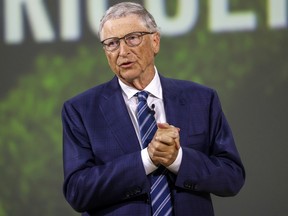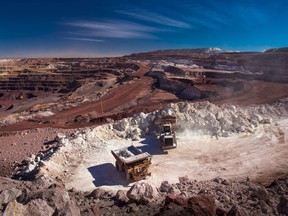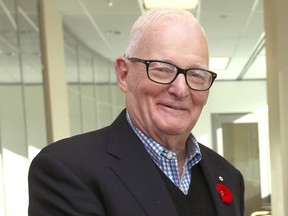At one point in time, Grant Sanden considered the eventuality that he’d sell GeologicAI.
That’s what he told Jim Gray, the Calgary business legend who co-founded Canadian Hunter Exploration, which sold in 2001 for $3.3 billion.
“He was very upset,” Sanden said.
Gray remembers it.
“I wasn’t up for that,” Gray said in an interview. “My philosophy, which not everybody shares, is to build a big company right here in Calgary.”
In response, Sanden homed in on a behemoth of a target: Breakthrough Energy Ventures (BEV), Bill Gates’ climate-focused venture firm and one of the world’s leading cleantech investors that has raised more than $2 billion, backed in part by the ultra-wealthy, including Jeff Bezos, Richard Branson and Michael Bloomberg.
“(Gray) said, ‘Grant, your goal is to get the world’s best investors. Don’t you dare sell this company,’ ” Sanden said.
Now, after quietly pulling in a $20-million investment from BEV, the Calgary-based company is planning to expand its 175-person staff to 2,000 people globally over the next two years. In September, it received an additional $10-million investment from Export Development Canada.
That head count will be dispersed to locations in Chile, Brazil, Africa and Australia — all major mining centres.

Miners leverage artificial intelligence to increase efficiency, reduce emissions
GeologicAI uses high-tech equipment and artificial intelligence to scan rocks for their contents, a long, uncertain and gruelling process. It’s a transformation from traditional core logging practices that include drilling rock samples and manual data entries.
This allows mining companies to efficiently identify rocks containing the minerals they need, and with major emissions reductions. (Each day, the company’s AI system processes more information than exists on Netflix, Sanden said.)
“This idea that you can act fast from defining drilling modelling and decide — that’s really a year-and-a-half process in the average mine, and we’re condensing it to days,” said Sanden, who grew up near Strathmore on a farm, which his eldest brother and father still run. He graduated from the University of Calgary with a degree in mechanical engineering and later got a citation in Applied Geostatistics from the University of Alberta in 2008.
“The ability to assess early and quicker is insanely valuable to the world, because we can accelerate, for example, copper production. The world needs twice as much copper as it has now.”
Rapid expansion of critical mineral production — needed for batteries, wind turbines and solar panels — is considered key to a net-zero transition.
“We just digitized that whole process and made it automated,” Sanden said.
The technology’s potential to rapidly expand the volume of critical minerals being mined for green technologies — and clamp down emissions in the process — made GeologicAI a clear fit for the fund, said Chris Rivest, partner at Breakthrough Energy and GeologicAI board member.
“You think about the requirements to really enable a clean transition and the requirements placed on the number of minerals (needed) . . . it’s just an enormous expansion of capacity,” Rivest said. “You have this fundamentally new data stream that is above and beyond what people have been using today to really enable you to more accurately determine what’s in the ground.”

‘Beautifully articulated vision of the future of what mining could be’
Breakthrough reviewed several competitors, Rivest said, but found those companies didn’t have the full suite of technology GeologicAI could provide.
“What we saw in GeologicAI was this amazing, beautifully articulated vision of the future of what mining could be when enabled by better data, enabled by better sensors and better data analysis,” Rivest said.
In a recent project applying its tech at Sishen mine in North Cape, South Africa — one of the world’s largest iron ore mines — the company alongside Resource Modeling Solutions (RMS), a geostatistical modelling company, demonstrated a 5.3 per cent reduction in carbon dioxide emissions during the steelmaking process.
(GeologicAI recently acquired GMS for an undisclosed amount.)
The discovery was a major finding for the steelmaking industry, one of the most carbon-intensive industries that accounts for more emissions than all road freight, according to data from the International Energy Agency (IEA). Overall, 3.5 billion tonnes of CO2 are emitted annually from steelmaking.
“What’s really fun is we’ve had a huge win on carbon dioxide emissions — bigger than anyone probably has ever had,” he said.
Agnico Eagle Mines Ltd., one of Canada’s largest gold producers with a market capitalization of $25.57 billion, wrote in a recent blog post that the technology used by companies such as GeologicAI represents “a new geological era.”

Groundbreaking technology hailed
Agnico uses GeologicAI’s scanning technology, as do several Alberta oilsands companies. Sanden said his company has recently secured large-scale projects in the Middle East, though the global expansion in mining is one of the company’s main drivers heading into 2024.
Agnico is using GeologicAI’s technology to “unlock the full potential” of its 646-square-kilometre land package in northern Ontario.
Rivest said the fund is invested in GeologicAI for the long haul to ensure it reaches the market.
“We’re solving climate change, which is in our view the most existential problem facing humanity over the course of the next century, and we view this as a long-term problem that we partner with companies on over the long term.”
Meanwhile, Gray understands that as the company swells, larger ones are going to start circling GeologicAI.
“At some point in time, they’re going to have some great big guy with deep pockets come along and try to bite them up for an astonishing amount of money,” he said. “I’d like to see these guys just hold the course, doing what they’re doing and build a great company.”
Sanden says the company’s priority is to “get this rolled out as fast as we can.”
“This might be one of the first times in the world where, ‘Can AI improve the environment directly?’ And the answer is yes.”
X: @mattscace67
-
 Varcoe: Tool or Terminator? Calgary conference explores risks, rewards of AI
Varcoe: Tool or Terminator? Calgary conference explores risks, rewards of AI -
 Calgary doctor pushes AI boundaries in heart disease
Calgary doctor pushes AI boundaries in heart disease -
 Startup using artificial intelligence to detect leaks at oil wells
Startup using artificial intelligence to detect leaks at oil wells
You can read more of the news on source



